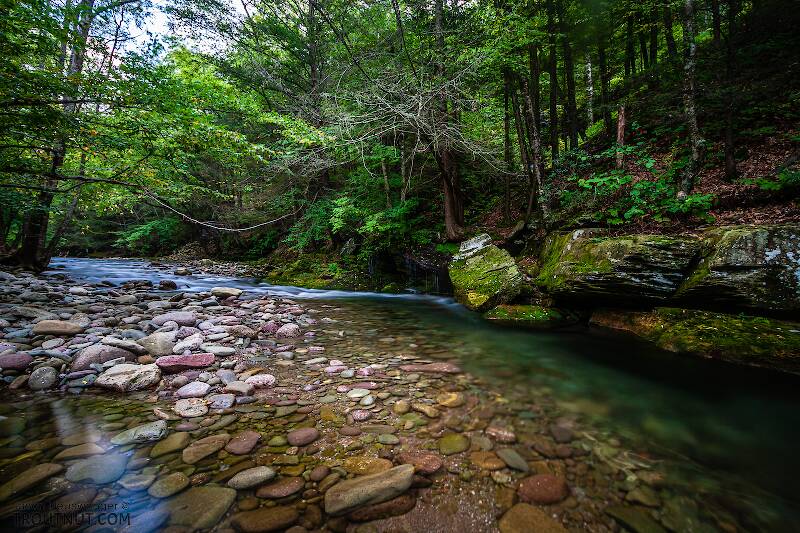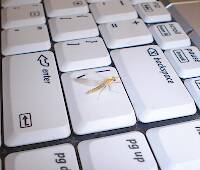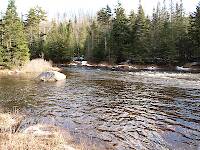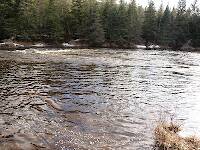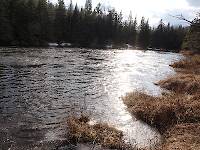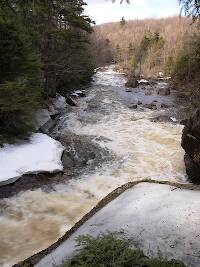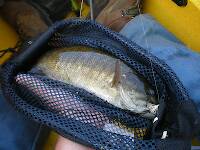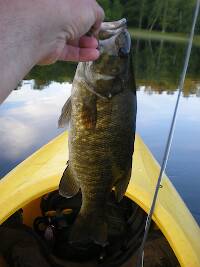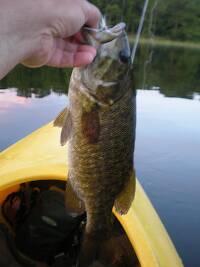
Hex Mayflies
Hexagenia limbata
The famous nocturnal Hex hatch of the Midwest (and a few other lucky locations) stirs to the surface mythically large brown trout that only touch streamers for the rest of the year.
Featured on the forum

This one seems to lead to Couplet 35 of the Key to Genera of Perlodidae Nymphs and the genus Isoperla, but I'm skeptical that's correct based on the general look. I need to get it under the microscope to review several choices in the key, and it'll probably end up a different Perlodidae.

Troutnut is a project started in 2003 by salmonid ecologist Jason "Troutnut" Neuswanger to help anglers and
fly tyers unabashedly embrace the entomological side of the sport. Learn more about Troutnut or
support the project for an enhanced experience here.
Shawnny3 on Feb 3, 2010February 3rd, 2010, 5:11 am EST
I was wondering how many Troutnuts tie in hand. I have just started doing it a little and have found some nice aspects to it. Do any of you have opinions or experiences to share about it?
-Shawn
-Shawn
Jewelry-Quality Artistic Salmon Flies, by Shawn Davis
www.davisflydesigns.com
www.davisflydesigns.com
Wbranch on Feb 4, 2010February 4th, 2010, 1:32 am EST
When I was a young boy of about 12 or 13 my parents and I went on vacation to New Brunswick, Canada and on the way back we stopped in a little town in northern Maine named Topsfield. We found a quaint old two story home that was renting rooms and was situated on a pretty big lake. The man and woman who owned the place said they were originally from NYC and the man had been quite a highly paid fellow who loved to fly fish. Anyway he could see I was very interested in learning to fly fish and he took me upstairs in a barn on the property (he told me and my Dad that was the only place his wife would let him smoke his cigar) I can still remember that old barn fifty-three years later. He had an old sofa in it and a coffee table and laying all over the place were fly reels, bait casting reels, literally dozens and dozens of bamboo fly rods (I wonder how many of them had been Leonards, Paynes, and Edwards??)
He also had dozens of metal fly boxes that were chock full with full dress salmon flies. Not those hairwing flies that are often seen in guys boxes today but married wing flies. He told me he tied many of his flies and that the next day we would go out with the square end canoe to a slow moving river, called Tomah Stream, and pursue smallmouth bass and pickeral with the fly rod. He told me he was going to teach me to tie a fly that he called the "Pieway Special". Decades later while reading Herter's fourteenth edition of
"Professional Fly Tying, spinning, and Tackle Making" I found a three page explanation of how to tie the "Mississippi Bug" as Herter drew, and called, it. Who knows maybe it was a coincidence or maybe our host was taking a little license with the origin of the fly.
He had one of those round metal tins that you used to be able to buy at the country hardware store, or Sears & Roebuck's, that was filled with an assortment of cheap black Sneck and O'Shaugussey hooks. He selected one that was quite large, I'd say no smaller than a #2, and put it on the table, then he got out a length of really heavy black thread - recalling it now it was probably "A" of heavier. He also got out a white bucktail. I honestly don't remember the tying steps but he did hold the hook between his thumb and forefinger and wound the thread onto it and half hitched it so it wouldn't unravel. Then he cut out a hank of white bucktail and tied it in at the shank so half of the fibers were on one side and about half were on the other side of the hook shank. He tied the hair in so about one third was on top of the shank and two thirds below the shank. He created a thread dam in front of each clump of hiar. He kept repeating this over and over until he got to the eye where he just half hitched it and cut off the excess. Then he took a pair of scissors and placed them about one half an inch above where the upper hair was affixed, and parallel to the shank, and proceeded to cut off the hair all the way back to the bend. After he made one he told me to try it and after 3 - 4 ugly attempts I was able to finish one that was acceptable to fish.
The next day he took my Mom, Dad, and me in this huge 20' wooden square end canoe with a little kicker to the Tomah Stream. It was really neat with many little openings in the wild grass just wide enough to pole the canoe through until we got to another channel. He knew the stream well and would say "cast over there by that branch, there is a cold water spring there" and I would cast and almost instantly you would see a pickeral, or a smallmouth, lunge out and grab the fly. It was one of those early formative experiences that we all have that galvanize us to fly fishing. I had kept some of the "Pieway Specials" for years as well as about a dozen of the full dress salmon flies he gave me but they have long since been lost. I sometimes wonder if I could tie another "Special" with just holding the hook within my fingers. Those are good memories, now though I prefer my HMH.
He also had dozens of metal fly boxes that were chock full with full dress salmon flies. Not those hairwing flies that are often seen in guys boxes today but married wing flies. He told me he tied many of his flies and that the next day we would go out with the square end canoe to a slow moving river, called Tomah Stream, and pursue smallmouth bass and pickeral with the fly rod. He told me he was going to teach me to tie a fly that he called the "Pieway Special". Decades later while reading Herter's fourteenth edition of
"Professional Fly Tying, spinning, and Tackle Making" I found a three page explanation of how to tie the "Mississippi Bug" as Herter drew, and called, it. Who knows maybe it was a coincidence or maybe our host was taking a little license with the origin of the fly.
He had one of those round metal tins that you used to be able to buy at the country hardware store, or Sears & Roebuck's, that was filled with an assortment of cheap black Sneck and O'Shaugussey hooks. He selected one that was quite large, I'd say no smaller than a #2, and put it on the table, then he got out a length of really heavy black thread - recalling it now it was probably "A" of heavier. He also got out a white bucktail. I honestly don't remember the tying steps but he did hold the hook between his thumb and forefinger and wound the thread onto it and half hitched it so it wouldn't unravel. Then he cut out a hank of white bucktail and tied it in at the shank so half of the fibers were on one side and about half were on the other side of the hook shank. He tied the hair in so about one third was on top of the shank and two thirds below the shank. He created a thread dam in front of each clump of hiar. He kept repeating this over and over until he got to the eye where he just half hitched it and cut off the excess. Then he took a pair of scissors and placed them about one half an inch above where the upper hair was affixed, and parallel to the shank, and proceeded to cut off the hair all the way back to the bend. After he made one he told me to try it and after 3 - 4 ugly attempts I was able to finish one that was acceptable to fish.
The next day he took my Mom, Dad, and me in this huge 20' wooden square end canoe with a little kicker to the Tomah Stream. It was really neat with many little openings in the wild grass just wide enough to pole the canoe through until we got to another channel. He knew the stream well and would say "cast over there by that branch, there is a cold water spring there" and I would cast and almost instantly you would see a pickeral, or a smallmouth, lunge out and grab the fly. It was one of those early formative experiences that we all have that galvanize us to fly fishing. I had kept some of the "Pieway Specials" for years as well as about a dozen of the full dress salmon flies he gave me but they have long since been lost. I sometimes wonder if I could tie another "Special" with just holding the hook within my fingers. Those are good memories, now though I prefer my HMH.
Catskill fly fisher for fifty-five years.
Shawnny3 on Feb 4, 2010February 4th, 2010, 6:56 am EST
Nice story, Matt. It has a musty feel to it, like most good memories. You tell it well.
-Shawn
P.S. That Herter is a character. First flytying book I had.
-Shawn
P.S. That Herter is a character. First flytying book I had.
Jewelry-Quality Artistic Salmon Flies, by Shawn Davis
www.davisflydesigns.com
www.davisflydesigns.com
Wbranch on Feb 4, 2010February 4th, 2010, 12:55 pm EST
Shawn,
"It has a musty feel to it, like most good memories. You tell it well."
Thanks for the kind words. Recently my short term memory seems to be on vacation but those long ago days of my youth are so fresh that I feel I can climb the stairs in the barn in Topsfield and nothing will have changed.
"It has a musty feel to it, like most good memories. You tell it well."
Thanks for the kind words. Recently my short term memory seems to be on vacation but those long ago days of my youth are so fresh that I feel I can climb the stairs in the barn in Topsfield and nothing will have changed.
Catskill fly fisher for fifty-five years.
Quick Reply
Related Discussions
Topic
Replies
Last Reply
5
Jun 22, 2012
by Falsifly
by Falsifly
4
Sep 4, 2015
by PaulRoberts
by PaulRoberts
1
Jun 13, 2011
by Oldredbarn
by Oldredbarn

